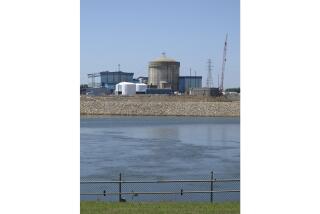U.S. Contractors Faulted in Uranium Plant Inquiry
- Share via
WASHINGTON — The Energy Department, ending the first phase of its investigation of the troubled Paducah, Ky., uranium plant, faulted contractors Wednesday for failing to warn the public about radioactive hazards, including “relatively high” levels of plutonium in ditches outside the plant.
Investigators wrapping up a six-week probe of the plant also pointed to the “theoretical” risk of an accidental nuclear chain reaction at the plant, citing large quantities of “uncharacterized” radioactive material stored there.
The problems were among dozens listed in a final report on environmental conditions at the Paducah Gaseous Diffusion Plant, one of two U.S.-owned facilities that produce enriched uranium. The report gives the plant’s managers 30 days to come up with a plan for addressing problems ranging from lax safeguards to radioactive seepage from a half-mile-long pile of contaminated scrap metal.
“We have concerns about exposure, but we don’t think any of them reach the level of imminent danger,” said David Michaels, assistant energy secretary for environment, safety and health.
Michaels promised quick action to eliminate any risk of a “criticality”--an inadvertent nuclear reaction similar to last month’s serious accident at the Tokaimura uranium plant in Japan. Agency officials said the chances of such a reaction are remote.
Energy Secretary Bill Richardson launched an investigation at Paducah in August after reports of worker exposure to and sloppy handling of radioactive waste. Draft results last month faulted the agency and its contractors for weaknesses in identifying and cleaning up contaminants--hazards that included highly radioactive plutonium.
Wednesday’s report contained the first results from independent laboratory tests that confirmed the presence of plutonium and other radioactive metals in ground water as well as in ditches and streams outside the plant fence. The agency’s tests found new areas of off-site contamination and also documented “relatively high levels” of plutonium, thorium and cesium in two ditches that feed a tributary of the Ohio River.
The contaminated areas had not been properly controlled or marked with signs. In fact, the report said, plant technicians were not aware the problems existed. Plutonium can cause cancer if inhaled in minuscule amounts.
Although plant officials discovered off-site plutonium contamination in the early 1990s, most public reports listed plutonium levels at near zero. The discrepancy has been a sore point with lawmakers who have grilled former contractors as part of their own probe.
Rep. Thomas J. Bliley Jr. (R-Va.), chairman of the House Commerce Committee, expressed dismay Wednesday that one former contractor, CH2MHill, continued to insist that the plutonium problem was contained within the plant’s security boundaries.
More to Read
Sign up for Essential California
The most important California stories and recommendations in your inbox every morning.
You may occasionally receive promotional content from the Los Angeles Times.













